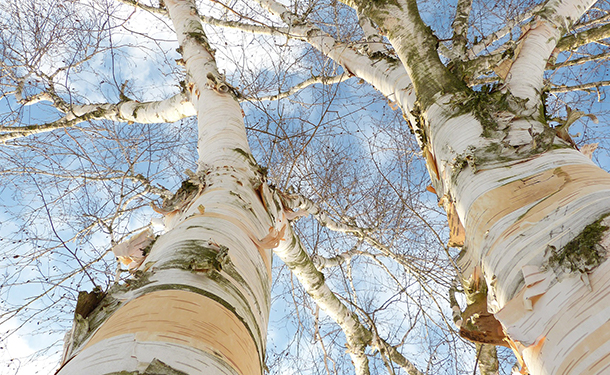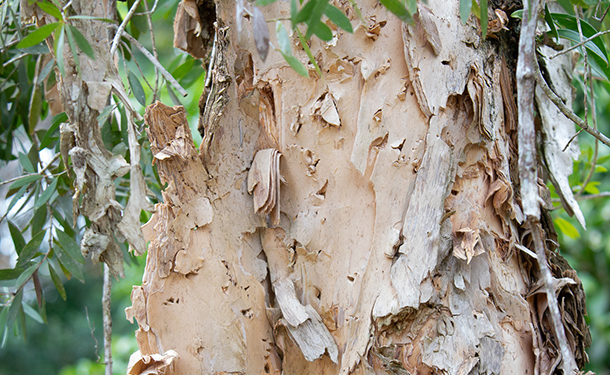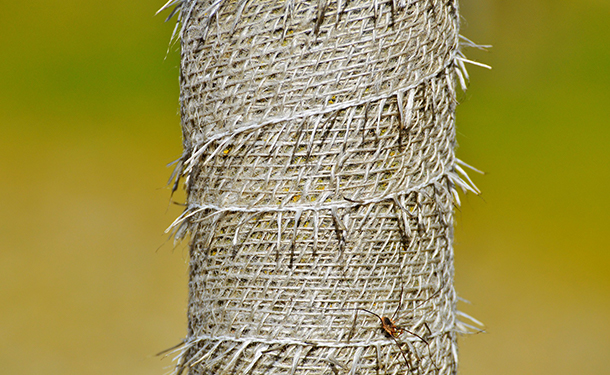Prevent your tree from being crippled or dying after its bark is damaged or removed. Knowing how to handle bark damage will help you keep your tree thriving.

thetreecareguide.com gathered information about tree bark, the problems bark often encounters, and solutions to help you keep your trees healthy.
What Is Tree Bark
Often referred to as the “skin of a tree,” tree bark, when you look just below the surface, you’ll see a layer of living tissue. This tissue is like a bundle of straws packed together, serving as conductive ‘pipes’ for transporting fluids. This tissue comes in two principal forms.
The first layer is the phloem. Phloem is right below the surface bark throughout the tree and carries sugars from the leaves to the rest of the tree. Deeper in is a layer called the xylem or sapwood. These tubes carry water, nutrients, and minerals the opposite way to the leaves.
Found between these layers is the cambium. The cambium produces cells. On the inside, it creates more xylem, and on the outside, it creates more phloem.
Xylem cells die quickly. This is necessary for them to play their role as pipes. They eventually become blocked and are replaced by newer xylem. This process surrounds the old layer, which is why a tree’s girth expands each year (adding to the number of growth rings). The blocked tubes become the heartwood of the tree. Heartwood gives the tree strength and is efficient at resisting disease and insect attack.
As phloem dies, it is pressed outward and becomes part of the bark. Many tree species have a cork cambium layer outside the first one. Its job is to produce cork, which also forms a significant portion of bark.
In short, everything outside the main cambium layer is considered the bark.

What Does Tree Bark Do?
Bark minimizes water loss from the trunk, branches, and stems, deters insect and fungal attack, and is a very effective shield against fire damage, as demonstrated by the incredible fire resistance of redwood and giant sequoia trees, which have massive bark.
The cork cambium provides a highly efficient barrier against many types and species of invaders. Being so resilient, it also isolates the outer secondary phloem and tissues from the rest of the wood, ultimately killing it. Thus, the outer bark is composed entirely of dead tissue.
Tree Bark Damage
Trees are subject to multiple types of injury that are usually unintentional, like automobiles, construction equipment, lawnmowers wounding the tree trunk or surface roots, or improper pruning. Naturally occurring events, like storms, fires, or damage by wildlife grazing/nesting may also cause severe wounds.
Wounds that severely damage and penetrate the bark damage the cambium layer (the thin layer of vascular tissue vital to water and nutrient movement). Such wounds expose the tree to successful insect infestation and disease attacks.
If less than 25% of the bark around the trunk has been damaged, the tree will likely recover. When such trunk wounds occur, any injured or detached bark should be carefully removed, leaving healthy bark that is firm and tight to the wood.
Through a process called compartmentalization, a wounded tree will attempt to save itself by sealing off damaged areas.
Note: Wound dressings (tree paint) are not necessary. In fact, You can observe the wound(s) closing from the edges inward each year – as the tree grows.
Tip: Storm-damaged branches should be correctly and immediately pruned away from the tree to expedite the healing process. Avoid pruning directly against or flush to the trunk since these cuts can result in extensive decay.
Tree Bark Protection
Damage prevention is far more effective and less costly than attempts at repairing the damage. You can protect a tree from equipment and mechanical injury by planting ground-cover plants or by spreading mulch around the tree. This protection method keeps a lawnmower and trimmer far from the tree’s trunk.
For more on landscaping around trees, read ‘How To Landscape Around Trees Without Killing Them‘.
Another element of tree bark damage occurs in the winter with sunscald. Light-colored tree wraps reflect sunlight and help prevent sunscald injury by keeping bark temperatures lower. The wraps should be in place by late fall and must be removed in early spring after the potential of hard frost has passed.
For further reading on saving a tree after dangerous bark damage or loss, visit ‘How To Save A Girdled Tree from Dying‘.

Tree Bark
In this article, you discovered what tree bark is composed of, what the different components do, problems trees often encounter, solutions to keep them healthy, and prevention measures you can take.
Knowing how to treat damaged tree bark will help you keep your tree safe from disease and insect infestation.
Poor handling of bark damages may quickly lead to the declining health of your tree audits untimely death.
Sources:
purdue.edu/fnr/extension/question-tree-bark-damage/
mortonarb.org/plant-and-protect/tree-plant-care/plant-care-resources/trunk-wounds-and-decay/
pubs.cahnrs.wsu.edu/publications/wp-content/uploads/sites/2/publications/fs197e.pdf